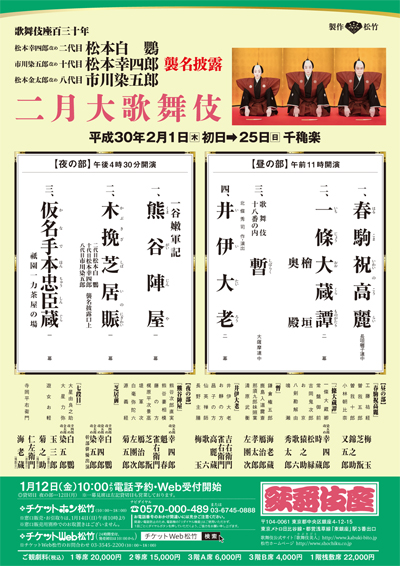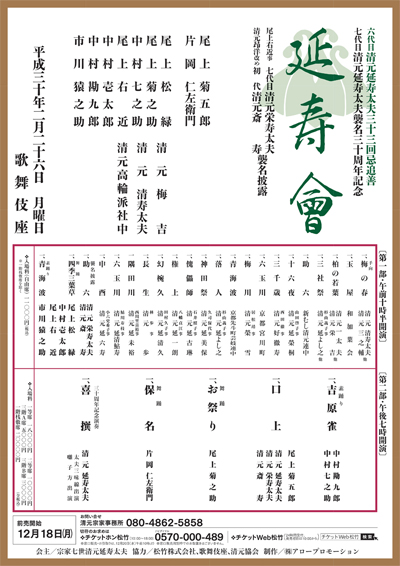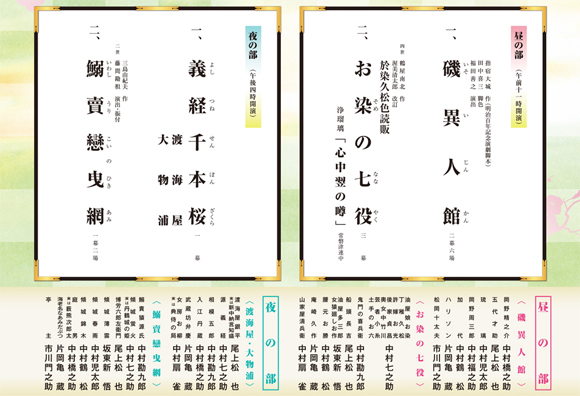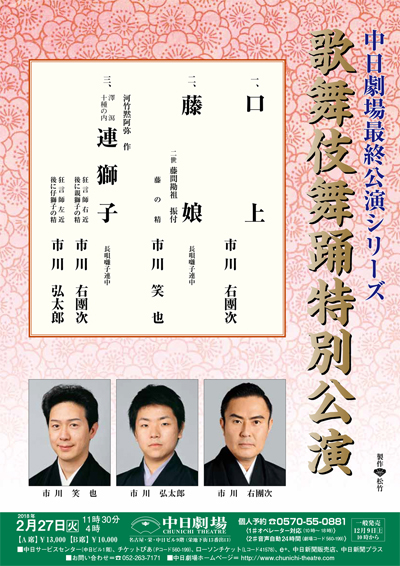| FEBRUARY 2018 |
|
3 shows in T˘ky˘ (Kabukiza), 2 in Fukuoka (Hakataza), 1 in Naruto (ďtsuka Museum of Art) and 1 in Nagoya (Chűnichi Theatre)!
|
| Kabukiza (T˘ky˘) |  |
| Dates | 1 ~ 25 February 2018 Nigatsu ďkabuki February Grand Kabuki |
| MatinÚe |
|
| Evening |
Ichi-no-Tani Futaba Gunki (Kumagai Jin'ya) Kotohogu Sandai Kabuki no Nigiwai |
| Casting |
Living National Treasure Sakata T˘jűr˘, Living National Treasure Onoe Kikugor˘, Living National Treasure Nakamura Kichiemon, Living National Treasure Band˘ Tamasabur˘, Living National Treasure Kataoka Nizaemon, Living National Treasure Nakamura T˘z˘, Matsumoto Haku˘, Matsumoto K˘shir˘, Ichikawa Somegor˘, Nakamura Shikan, Nakamura Jakuemon, Nakamura Tokiz˘, Kataoka Gat˘, Onoe Kikunosuke, Nakamura Baigyoku, Nakamura Kaishun, Nakamura Ganjir˘, Nakamura Kinnosuke, Ichikawa Sadanji, Kataoka Hidetar˘, Ichikawa Ebiz˘, Ichikawa Ennosuke, Onoe Sh˘roku, Nakamura Karoku, Nakamura Matagor˘, Ichikawa Komaz˘, Band˘ Yajűr˘, Band˘ Rakuzen, Band˘ Hikosabur˘, Band˘ Kamez˘, ďtani Tomoemon, Ichimura Kakitsu, Ichikawa Sai'nyű, Ichikawa Udanji, Kataoka Ichiz˘, Nakamura Matsue, Nakamura Baishi, Nakamura Yonekichi, Nakamura Umemaru, Arashi Kitsusabur˘, Sawamura S˘nosuke, Onoe Ukon, Ichikawa Kudanji, Ichikawa Omez˘, Band˘ Minosuke, Ichikawa K˘tar˘, Nakamura Kichinoj˘, Nakamura Kamenoj˘, ďtani Hirotar˘, ďtani Hiromatsu, Nakamura Kash˘, Nakamura Hayato, Nakamura Mantar˘ |
| Comments |
The traditional two programs for the February Grand Kabuki at the Kabukiza, which celebrate the second month of the 3-generation K˘raiya shűmei (K˘raiya Sandai Shűmei) of Matsumoto Haku˘ II, Matsumoto K˘shir˘ X and Ichikawa Somegor˘ VIII.
|
 |
| Dates | 26 February 2018 Enjukai |
| MatinÚe |
Ume no Haru Tamaya Kashiwa no Wakaba Sanja Matsuri Sukeroku Izayoi Michitose Mutamagawa Umegawa Seigaiha Ochiudo Kanda Matsuri Kairaishi Gonj˘ Maboroshi Wankyű Ch˘sei Sumidagawa Mutamagawa Sarutori Sukeroku Shiki Sanbas˘ Seigaiha |
| Evening |
Yoshiwara Suzume Omatsuri Yasuna Kisen |
| Casting |
Living National Treasure Onoe Kikugor˘, Living National Treasure Kataoka Nizaemon, Onoe Kikunosuke, Nakamura Kankur˘, Nakamura Shichinosuke, Ichikawa Ennosuke, Onoe Sh˘roku, Nakamura Kazutar˘, Onoe Ukon |
| Comments |
Onoe Ukon, the grandson of Kiyomoto Enjudayű VI and the son of Kiyomoto Enjudayű VII, takes the name as a music master of Kiyomoto Eijudayű VII at the Kabukiza. This is a special Kiyomoto gala program, which commemorates the 32nd anniversary (33rd memorial services) of the passing away of Kiyomoto Enjudayű VI. This program is entitled "Enjukai". Onoe Ukon's elder brother Kiyomoto Takahiro takes the name of Kiyomoto Saiju in the same program. |
 |
|
|||
| Dates | 2 ~ 25 February 2018 Nigatsu Hanagata Kabuki February Young Actors Kabuki |
||
| MatinÚe |
Iso Ijinkan |
||
| Evening |
|
||
| Casting |
Nakamura Kankur˘, Nakamura Shichinosuke, Nakamura Senjaku, Onoe Matsuya, Ichikawa Monnosuke, Kataoka Kamez˘, Nakamura Kotar˘, Band˘ Shingo, Nakamura Hashinosuke, Nakamura Fukunosuke, Ichikawa Fukutar˘, Nakamura Tsurumatsu |
||
| Comments |
Young actors performing at the Hakataza.
|
||
  |
| ďtsuka Museum of Art (Naruto) |
| Dates | 15 ~ 18 February 2018 Sistine Kabuki |
| Program |
GOEMON (Romanesuku) |
| Casting | |
| Comments |
8th edition of the Sistine Kabuki, a Kabuki program within the Sistine Hall of the ďtsuka Museum of Art, which is located in the city of Naruto (Tokushima prefecture). Inside this museum, there are more than 1,000 replicas of priceless masterpieces of Western art, from ancient murals to modern paintings, which are reproduced in ceramic to their original size. The Sistine Hall is of course a "reproduction" of the Vatican Sistine Chapel. A newly-created "romanesque" (romanesuku) ishikawa-goemonmono is staged with Kataoka Ainosuke in the prestigious role of the legendary thief Ishikawa Goemon. |
|
|||
| Dates | 27 February 2018 Kabuki Buy˘ Tokubetsu K˘en Kabuki Dance Special Performances |
||
| Program | |||
| Casting | |||
| Comments |
A special program in Nagoya at the Chűnichi Theatre. This theater will stop its activities at the end of March 2018 as it is located inside the Chűnichi Building, which will be destroyed and rebuilt due to its old age.
|
||
 |
|
|
| Contact | Main | Top | Updates | Actors | Plays | Playwrights | Programs | Links | FAQ | Glossary | Chronology | Illustrations | Prints | Characters | Derivatives | Theaters | Coming soon | News |
